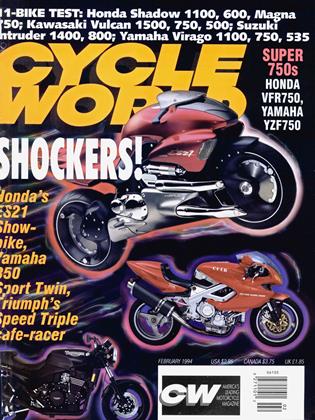YAMAHA VIRAGO 750
CRUISER COMPARISON
Classic custom, a decade later
YAMAHA'S VIRAGO 750 LOOKS like a cruiser should. It has the signature teardrop tank, a buckhorn handlebar, a stepped seat, dual exhaust pipes and acres of deep, rich chrome. Introduced in 1981, the Virago 750 was the first Japanese cruiser to take on Milwaukee. Obviously, the Virago didn't put Harley-Davidson out of business, but the correctness of its look has had much to do with its longevity.
There’s nothing terribly high-tech about the Virago’s powerplant, a 75-degree, 749cc, sohc V-Twin. Still, the air-cooled engine performs reasonably well compared to the more advanced powerplants from Kawasaki and Suzuki. In side-by-side, top-gear roll-ons, for example, the Virago would initially pull the Vulcan before fading as speeds neared triple digits.
The Virago’s handling is also noteworthy. While its folding footpegs touch down easily, the Yamaha is rela-
tively light, and possesses rational steering geometry, giving it a nimbleness that few cruisers possess. The suspension is equally impressive, especially the springpreload adjustable shocks, which do a good job of soaking up bumps and ripples in a broad range of riding environments. Its front brakes, though a dated design, also work well; the single-piston, double-action calipers and 10.5inch rotors offer excellent feel and good stopping power.
On the debit side, the Virago’s seat could use some help. The saddle looks thick and plush, but less than an hour on the freeway will have your backside believing otherwise. Furthermore, the Yamaha’s five-speed transmission would benefit from smoother actuation.
But at $5599, $1200 less than the Magna, the Virago 750 is priced right, which makes its pearlescent green paint, superb styling and commendable performance even more appealing.
$5599
 View Full Issue
View Full Issue
More From This Issue
-
 Up Front
Up FrontWales Watching
February 1994 By David Edwards -
 Leanings
LeaningsRushville Revisited
February 1994 By Peter Egan -
 TDC
TDCGetting Started
February 1994 By Kevin Cameron -

Letters
February 1994 -
 Roundup
RoundupYamaha's Gts1ooo: Brilliant But Unsold
February 1994 By Jon F. Thompson -
 Roundup
RoundupHot Colors For A Cool Honda
February 1994 By Jon F. Thompson



